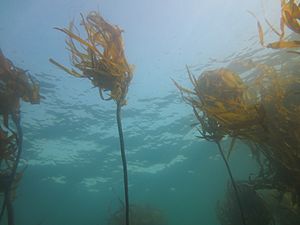Nereocystis facts for kids
Quick facts for kids Nereocystis |
|
|---|---|
 |
|
| Nereocystis luetkeana at Caspar Point, California | |
| Scientific classification | |
| Genus: |
Nereocystis
|
| Species: |
luetkeana
|
Nereocystis is a type of large kelp that lives underwater. It's often called bull kelp because of its big, strong shape. Its scientific name, Nereocystis, comes from Greek words meaning "mermaid's bladder."
This amazing kelp is very important for kelp forests. It grows in thick groups on rocks deep under the ocean's surface. You might also hear it called edible kelp, bullwhip kelp, or ribbon kelp. Just be careful not to confuse it with "southern bull kelps," which are different types of kelp found far away in the Southern Hemisphere.
Contents
How Bull Kelp Got Its Name
The scientific name for bull kelp is Nereocystis luetkeana. The "luetkeana" part was given to it by a scientist named Mertens. He named it after a German-Russian explorer, Fyodor Petrovich Litke. Later, two other scientists, Postels and Ruprecht, gave it the full name we use today.
What Bull Kelp Looks Like
Bull kelp is one of the fastest-growing plants on Earth! It can grow super long, up to about 36 meters (118 feet). That's like a 12-story building!
Each bull kelp plant has a few main parts:
- Holdfast: This is like the kelp's roots. It's a strong, branched part that grips onto rocks at the bottom of the ocean. It can be about 40 centimeters (16 inches) wide.
- Stipe: This is the long, rope-like stem that grows straight up from the holdfast. It's usually cylindrical and can be very long.
- Pneumatocyst: At the top of the stipe, there's a single, gas-filled float. This float is like a balloon that helps the kelp stand upright in the water, reaching towards the sunlight. It even contains a gas called carbon monoxide!
- Blades: Many long, ribbon-like leaves, called blades, sprout from the pneumatocyst. There can be about 30 to 64 blades on one plant. Each blade can grow up to 4 meters (13 feet) long and 15 centimeters (6 inches) wide.
These blades can grow incredibly fast, sometimes as much as 15 centimeters (6 inches) in just one day!
Life Cycle and Reproduction
Bull kelp usually lives for about one year, but sometimes it can last up to 18 months. When it's time to reproduce, special patches called sori grow on the blades. These patches contain spores, which are like tiny seeds.
What's really cool is that Nereocystis is the only type of kelp that drops these spore patches directly to the seafloor. This helps make sure that new kelp plants grow close to where the parent plant was, keeping the kelp forest strong.
Where Bull Kelp Lives
You can find bull kelp all along the Pacific Coast of North America. It grows from Southern California all the way up to the Aleutian Islands in Alaska. Sometimes, pieces of bull kelp break off and float with ocean currents even further south into Mexico.
This kelp loves to grow on rocks in areas where the water is moving a lot, like in strong currents. It can live in shallow water near the shore or in deeper offshore beds. It often grows alongside other types of kelp, like Eualaria or Macrocystis.
See also
 In Spanish: Nereocystis para niños
In Spanish: Nereocystis para niños
Images for kids
-
Bull kelp near Cambria, California. You can see the top of the stipe, the pneumatocyst (float), and the blades on this kelp that washed ashore.


